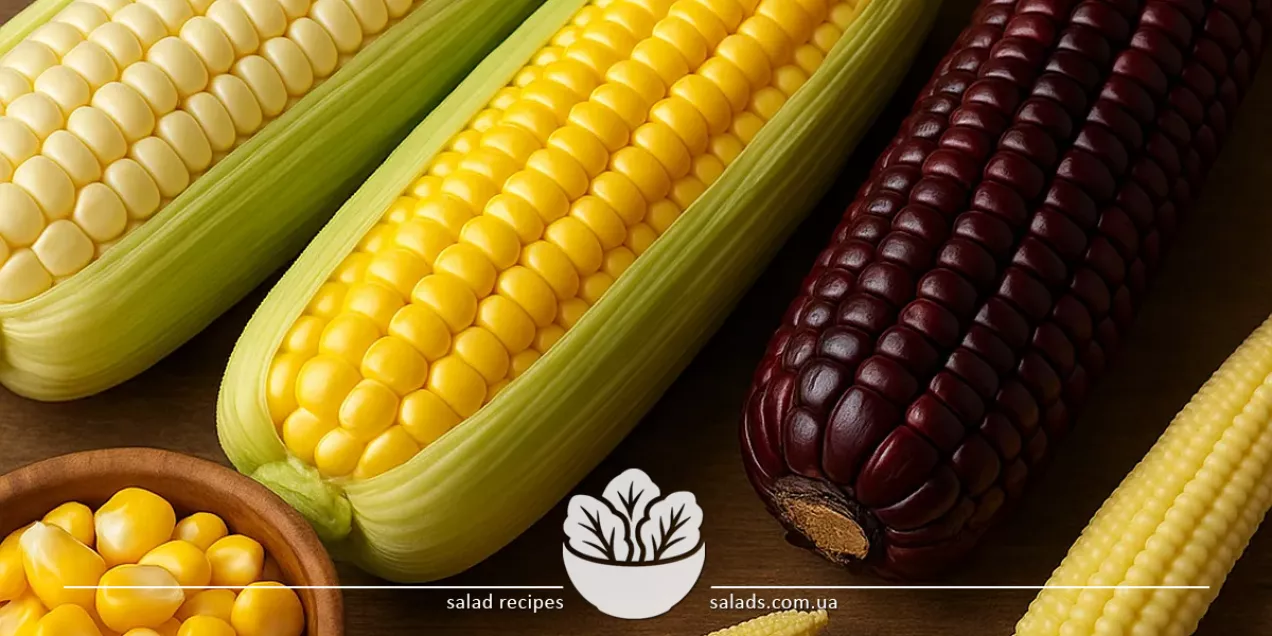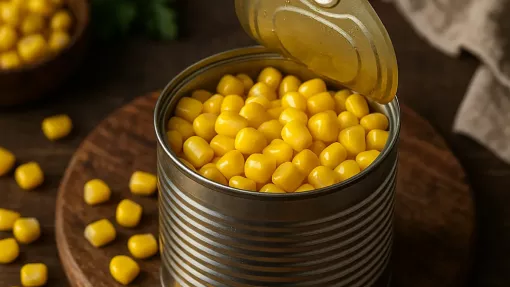Corn

Corn is a bright yellow vegetable that combines natural sweetness, nutritional value, and cooking versatility. It can be served on the cob or as individual kernels, fresh, boiled, baked, fried, or canned. Corn is popular in many world cuisines – it is added to salads, appetizers, stews, soups, and also used as a side dish. Thanks to its high fiber content, B vitamins, and antioxidants, it is not only tasty but also healthy. Read more about other vegetables in the vegetables category.
Different Types of Corn
Various Forms and Types of Corn
Corn comes in several culinary forms, each used in a different way. The most common option is fresh corn on the cob. Young cobs have tender, sweet kernels that are perfect for boiling or baking. They are often cooked in salted water, on the grill, or in the oven with butter and spices. Boiled corn is served as a standalone dish or added to sides and salads. Individual corn kernels are used more broadly – in salads, soups, and snacks. They can be removed from cooked cobs or used in canned form. Canned corn is convenient for everyday meals, as it requires no additional processing. The kernels retain their sweet taste and pleasant texture, pairing well with vegetables, meat, rice, and pasta. Frozen corn is also widely used in dishes where maintaining kernel structure after heating is important.
Popcorn holds a special place – it’s a specific corn variety with a dense outer shell. When heated, steam builds inside the kernel, causing it to burst and transform into a fluffy puff. It’s a popular snack that can be made salty, sweet, spicy, or neutral depending on the seasoning. There are also ornamental corn varieties with dark red, purple, or blue kernels, mostly used for decoration or as raw material for flour. Corn often pairs with colorful vegetables that highlight its yellow tone. For example, salads with corn and sweet peppers are a classic combination for a bright, crisp, and sweet appetizer. These ingredients harmonize perfectly in texture, color, and flavor.
Corn in Salads, Appetizers, and Side Dishes
Corn kernels are perfect for creating colorful salads and quick appetizers. With their sweetness, juiciness, and pleasant crunch, they pair well with many ingredients. The most popular salads include eggs, cheese, green peas, chicken, or ham. Corn softens and balances salty, fatty, or spicy components, making it an essential part of many classic recipes. Vegetarian salads often feature corn with tomatoes, cucumbers, avocado, spinach, or leafy mixes. These can be topped with a light dressing based on oil, yogurt, or lemon juice. In Mexican cuisine, corn kernels are combined with black beans, chili, cilantro, red onion, and lime – resulting in a hearty, nutritious, and fresh dish. Combined with soft cheese, sour cream, or mayonnaise, corn becomes a key part of rich winter salads.
As a side dish, corn is often paired with other vegetables. It’s stewed with carrots, peas, onions, and zucchini. It can also serve as a garnish for main dishes – thanks to its vibrant color, the kernels highlight roasted meats, fish, or hot casseroles. Corn kernels can be pan-fried with butter, herbs, and spices – making a quick warm snack or wrap filling. Corn is especially popular when paired with tomatoes. This combination is used not only in salads but also in sauces, stews, and casseroles. Tomatoes add acidity, juiciness, and aroma, while corn contributes sweet crunch. This duo is perfect for light summer meals as well as for bold Latin American recipes.
Corn in Soups, Skillet Meals, and Casseroles
Corn is not limited to salads – it is actively used in soups, stews, and casseroles. In soups, it adds a slightly sweet flavor and pleasant texture. A creamy corn soup with potatoes and cream is a popular option for lunch or dinner. It is served with croutons, cheese, or sautéed onions. In broth-based soups, corn kernels are added at the end to preserve juiciness. It is often found in chicken soups or vitamin-rich vegetable broths. Corn is also used in skillet meals – such as vegetable mixes with zucchini, eggplant, carrots, or peppers. It’s added to dishes like stews or vegetable spreads, where it lends sweetness and enhances texture. In recipes like paella or pilaf, corn can replace or complement peas, adding color and juiciness. It pairs well with grains – rice, bulgur, couscous.
In casseroles, corn often plays a background role, blending with cheese, eggs, meat, and potatoes. It can be part of the filling or a separate layer. A popular American dish – corn casserole – is made with eggs, cream, flour, and plenty of corn. In Mexican cuisine, corn is used in enchiladas, nachos, quesadillas, and other dishes with cheese, meat, and vegetables. For richer flavor, corn is often combined with onion. Onion adds sweetness, aroma, depth, and balance. It’s sautéed until golden or caramelized, then combined with corn in side dishes, soups, or baked meals.
Combining Corn with Other Vegetables and Legumes
Corn pairs well with many vegetables and legumes, making it a common ingredient in complex salads, vegetable blends, and soups. It goes well with cucumbers for freshness and crunch, zucchini for a soft texture, green peas to amplify sweetness, and beans for added nutrition. A classic combination is corn with beans. This is frequently used in Mexican cuisine. Such salads typically include red or white beans, corn kernels, peppers, onions, tomatoes, herbs, and a spicy dressing. These salads can be served as a main dish or a side for meat or fish. Corn with beans is also perfect for warm vegetable stews or chili sin carne dishes.
Corn also works well with stewed vegetables, especially tomatoes, carrots, and eggplants. It is added to vegetable casseroles, sautéed mixes, and soups. In vegetarian dishes, corn serves as a carbohydrate source, replacing pasta or grains. It pairs easily with mushrooms, root vegetables, broccoli, and aromatic herbs like dill, parsley, or thyme. Corn is very practical for appetizers – it cooks quickly, adds juiciness, volume, and a texture contrast. Canned corn can be added to sandwiches, tartlets, rolls, vegetable pâtés, or stuffed vegetables. In such recipes, it pairs well with beans, which add protein, density, and balance the sweetness of the corn.
How to Choose, Store, and Cook Corn
Choosing the right corn is key to great taste and texture in your dish. For fresh cobs, look for ones with dense, juicy kernels in the milk stage of ripeness. The husk should be green, and the silk moist and light-colored. If the kernels are hard or wrinkled, it means the corn is overripe or has been stored too long. Young cobs can be boiled or grilled without husking – this preserves aroma and natural moisture. Loose corn kernels should be refrigerated and used within a few days. Canned corn should be stored in a sealed container and, once opened, transferred to a glass or plastic container with a lid and used within 2-3 days. Frozen corn can be stored in the freezer for up to 8-10 months without flavor loss. It doesn’t need to be defrosted – just add it directly to hot dishes.
When cooking corn, it’s important to consider its texture. Boiled kernels can overcook easily, so they are added at the final stage. Frying or baking gives corn a nutty flavor and golden hue. If used in salads, the kernels should be cooled after boiling to avoid softening other ingredients. In soups, corn is often paired with milk, cream, or broth to create a rich taste. Corn combines well with fresh vegetables – such as cucumbers. This duo is ideal for light summer salads: corn adds sweetness, cucumbers bring freshness and a light crunch. Depending on other salad ingredients, spices, dressings, and add-ins can be varied – corn remains a universal ingredient that adapts easily to any cuisine.
